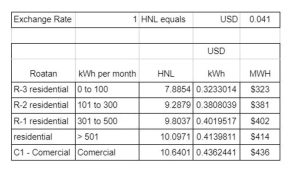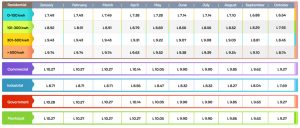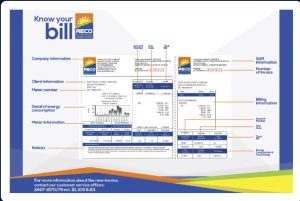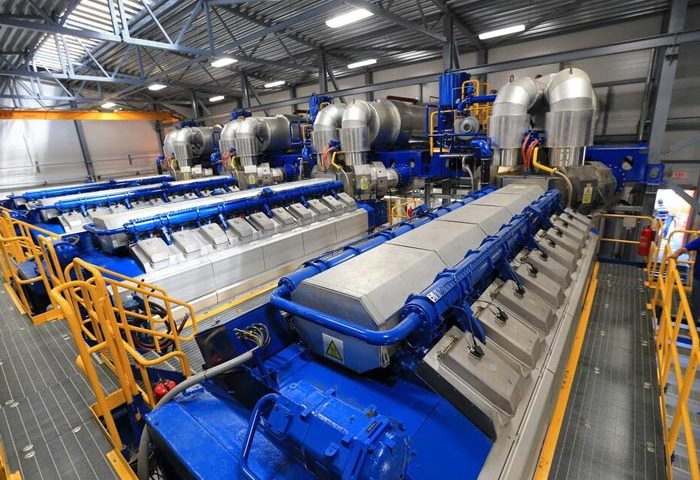Where does Roatan get it’s electricity from?
“And God said, ‘Let there be light’ and there was light, but the Electricity Board said He would have to wait until Thursday to be connected.”
Spike Milligan
RECO and RECO on Facebook
The much-maligned RECO
You can’t talk about electricity on Roatan without using the “R” word. RECO is the generator and distributor of electricity for Roatan and will be for the next few decades. It has a monopoly from the federal government that cannot be reversed, no matter what local politicians campaign on! You, of course, can generate your own electricity, and many resorts and some off-grid housing do indeed have their own gas/propane/diesel generators, solar panels, or wind turbines.
Most of the people who complain about RECO do so due to sticker shock. If you are a Honduran who has moved from the mainland, then suddenly your price per kilowatt-hour (kWh) has more than doubled. They are outraged. The outrage is misplaced. Hydropower generates 42% of the power on the mainland, so the cost of production is far less. Also, the infrastructure is old and failing there, and ENEE does not charge enough to keep it maintained. In other words, the government keeps the prices artificially low as the majority of the population could not afford the true cost of the power. This is a vicious circle, and eventually, there will be serious problems with the power grid on the mainland. Outages there are already familiar events.
Power is expensive here, but the costs are in line with other islands in the Caribbean. I have compiled a list of “fully loaded” power costs for various usages. 100 kWh and 400 kWh would be considered residential, whereas 800 kWh would be considered commercial. On the non-RECO ones in the diagram, I cannot be sure there are no extra taxes charged on top of these figures, as they are self-reported. The RECO one includes taxes, municipal fees, and the 10% discount given when they built the more efficient plant. Honduras also gives a discount to people who qualify under “tercera edad” (old age), but that is capped at 1,000 HNL. To compare pricing, I have used a report from “An Association of Electrical Energy Solution Providers Caribbean Electric Utility Services Corporation,” or CARILEC for short. The report is from September 2021, and I calculated and added RECO’s charges at the top. I have rounded all figures up to the nearest dollar. Note the biggest exception on the sheet is Trinidad & Tobago, which shows what a difference there is when you own the source of the hydrocarbons you use to generate the power. Again, this is why power is so cheap on the mainland as 42% is produced by Hydropower.”
CARILEC
An Association of Electrical Energy Solution Providers
Caribbean Electric Utility Services Corporation
Tariff Report September 2021
Caribbean Comparison.
I take responsibility for all errors I have tried to make it as accurate as possible.
Why are the costs so high?
Roatan has to import all its fuel, so not only does it have to purchase diesel or LPG to power the plant, but it must also transport and store that fuel in sufficient quantities to keep the generators running. It has to be able to store enough in hurricane and earthquake-proof containers such that, if the weather or other circumstances prevent deliveries, it has a healthy stockpile. When you compare the cost to other Caribbean islands, as I have done below, you can see that Roatan’s prices are high but not significantly above the Caribbean average. The chart above shows an example of three different usages, each triggering different rates.
If you are interested in the exact amount that you are charged per kWh, it is based on your usage in this particular billing cycle. As of July 2022, these were the published rates. The less you use, the cheaper the rate

An informative guide to Roatan’s electricity tariffs: Understanding your costs per kilowatt-hour in both local and international currency.

An overview of the electricity tariff rates for residential and commercial users in Roatan, Honduras, for the period January to October 2023.
Why we are lucky to have RECO!
So why do I think we are lucky to have RECO? Well, first let me tell you what it was like 17 years ago when we arrived. RECO was a collective that had been put together by some of the wealthier people on the island, and all customers were, in essence, shareholders. However, it did not earn enough money to pay for fuel or the maintenance of the generators. If a generator broke, you could be waiting weeks for it to be fixed, or sometimes there was just not enough fuel to run them. Theft from the power lines was rampant. Power would often be out all day for weeks. Generators were essential. You could not conduct business or have lights in your home without one. The major resorts all had to have their own generators because they could not rely on power. Everyone had to have gas to cook, and you could forget trying to keep things refrigerated; it was a living hell.
To have any kind of service in your community, regardless of whether it is a police department, fire station, hospital, or power generation, you need to have the population and tax income to support it. Roatan does not generate a huge income, as you can see from the underfunded public hospitals, schools, and police force. Roatan does not have the money to support the massive capital investment that has been put into RECO. If we had a power plant that reflected the population, then it wouldn’t be a fiftieth the size of RECO.
A few years ago, I was doing some radio shows on the island for fun. One was an hour-long interview with RECO, and so I know that about seven years ago, the island was using something like 10 MW regularly, and at peak times like Semana Santa, 14 MW. RECO built a $45 million (my estimate) 24 MW plant that, at the time of building, was the most advanced of its type in the world. It can switch between one of three different fuel supplies in a matter of hours, so they can always use the lowest-priced fuel. At the moment, that happens to be LPG. It has three 8 MW generators that could be online, so its capacity far surpasses the needs of the island.
They have also spent $7 million building a 3 MW wind farm. Though it is a small percentage of our needs, it contributes and was not cheap. I estimate another $7 million in investment. Recently, they have built two solar farms, a 7 MW and a 5 MW solar plant, along with a large battery backup capacity (10 MW/26 MWh energy storage solution) that can power the island for an hour on its own. This allows them to control the phase and flow of the electricity, causing fewer “brownouts” and fewer outages altogether. Recently, they put a $7 million submarine cable to St. Helene and beyond to power about 700 houses. The battery also means they do not waste power when running the generators; any extra power generated can be used to charge the batteries, which can then be put back into the system a little later.
We have times when they tell us we will not have power for several hours; that is because they are converting all the old wooden power poles that only last 7 years to concrete ones that should last 30 years – well, if taxis can stop crashing into them. They also need to move the power lines with the construction and widening of the roads and to do any significant changes to the network.
This is a huge amount of money to be invested in Roatan, an investment in purely economic terms that is not reflective of the current or near-term client base. I would estimate somewhere between $70 – $100 million for an island that has only a few large hotels and no large commercial businesses to speak of. You can argue over the reasons why RECO has made the investment, but that is not relevant to this discussion. They have, and we are lucky to have it. Some people argue that this is why the electricity costs are so high. No, they are high because we are an island. By law in Honduras, being a utility and a monopoly, RECO is not allowed to make more than a certain percentage profit on its revenue, which I think is capped at 10%, and believe me, they have survived multiple outside audits as politicians try to gain popularity by pulling them down
Why do some outages last seconds while others last hours
One of the reasons we can have sudden and unexpected outages is that, unlike most power systems, the power basically travels in a line from one end of the island to another. If more power lines were installed so it could become a circle, they would be able to isolate sections far quicker and more efficiently, providing better service to all the customers. However, that would be a massive undertaking and would involve upsetting a lot of people, as new power poles would have to be placed over their land. So we have to live with some inconvenience.
If a taxi takes out a power pole or a tree falls over from erosion onto the lines, then all the people past that point will lose power for as long as it takes to safely remove the problem, fix it, and then energize the line. A serious undertaking, especially in a storm. You may have noticed the power going out for a few seconds to a minute at a time. That is because of the inclusion of “circuit breakers” at certain points along the line. In the past, a branch hitting a power line would take the whole line up to the power station out. However, now the electrical short trips the breaker. After a short period, the breaker automatically energizes the line again, and if the problem is gone, the power returns. If not, out it goes again. These breakers save us from much longer outages.
Irrespective of the owner’s reasons for this outlandish investment in infrastructure here, it allows for the possibility of far greater growth for the island. This infrastructure allows us to attract investment that would just not be possible without it.
Customer service.
RECO has done a terrible job over the years of public relations and customer service. I have some personal horror stories that I enjoy sharing as examples of the worst customer service practices I have seen anywhere in the world. Some of its procedures make you want to bang your head against the wall, but it is improving, even if it is just because there is less and less to complain about as the infrastructure steadily improves. As you can see, I am a supporter of RECO, though ironically, they don’t think so. I even created their Facebook page for them and connected it to the linemen to help facilitate problems being reported early on in their growth. Still, I would rather have the technology we have on the island and bad customer service than have great customer service and the system our island actually could pay for with taxes.
RECO bill
I will give a quick explanation of a RECO bill. First, of course, there are no addresses on Roatan, so your address can be as strange as the “Blue house close to West Bay zip line.” These bills sometimes get lost. You should, by now, do everything online; it is the only way to be sure everything goes smoothly. When you buy a property, it is important to make sure it is transferred properly into your name. REMAX will facilitate this as a service, but it takes time; sometimes several months.
I have identified the most likely items you will see on your bill. Historical consumption is important as you can see if you have something going wrong. That could be anything from leakage of water or a running toilet, so your water pumps are constantly switching on to maintain the pressure. Sometimes they read the meter wrong, or maybe you are leaving the AC/fans on too much.
Below are some of the standard codes you will see on your bill. The worst part is the fuel adjustment as you can imagine, especially over the year. Rates are fixed and can only be changed by government decree, but the price of fuel varies and therefore so does the cost of your electricity. You might see the cost of LPG fall in the news, but RECO may be locked into prices they bought 4 months ago. So if you notice your bill seems to be increasing though you’re using the same amount of electricity, this is usually the culprit. The government subsidy was negotiated when RECO wanted to build the more efficient plant it has today. The government made them reduce prices by 10% to allow them to build it.
Lattest information on how to pay our bill can be found on the RECO website here.

An annotated sample of a RECO bill, breaking down each item to help Roatan real estate owners and investors make sense of their electricity expenses
How much electricity does the island use, and where does it come from?
In a typical month, we will use about 10,000 Megawatt-hours of power; this is produced from various sources but roughly:
- 78% from the LPG plant
- 3% from Diesel
- 0.5% from trade winds
- 8% from solar
- 2-3% from the batteries discharging (don’t think about that too hard)
10 years ago, we were 100% Diesel generated. Quite a change.
If you have further questions, feel free to email me or peruse RECO’s website or Facebook page.
Propane delivery
SolGas 2445-1171
Bip Gas Contáctanos *LPG (*574) type “*574 on your phone
BIP has four locations open 7 am to 5 pm Monday to Saturday
Coxen Hole French Harbor Sandy Bay and Oakridge,
I believe they even have apps so you can order them.
Other utilities such as the tv-and-internet-on-roatan can be found in this chapter.
